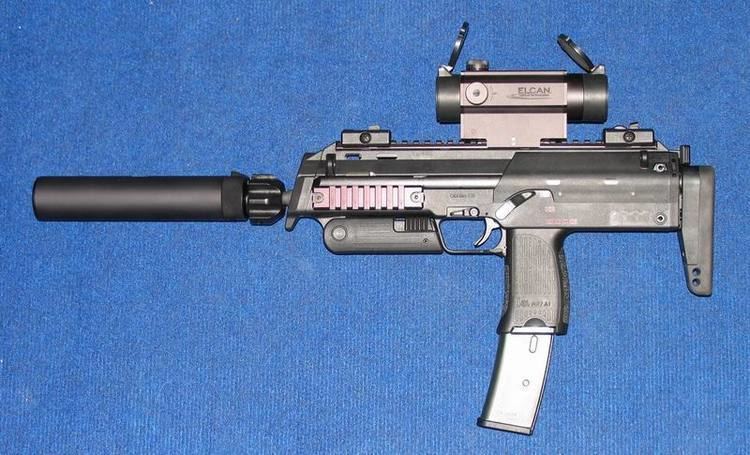Manufacturer Heckler & Koch | In service 2001–present | |
 | ||
Type Personal defense weaponSubmachine gunMachine pistol Used by 20+ countries (see Users) Wars War in Afghanistan (2001–14)Operation Iraqi Freedom2013 Lahad Datu standoff | ||
The MP7 is a German Personal Defence Weapon (PDW) manufactured by Heckler & Koch (H&K) and chambered for the HK 4.6×30mm cartridge. It was designed with the new cartridge to meet NATO requirements published in 1989, as these requirements call for a personal defense weapon (PDW) class firearm, with a greater ability to penetrate body armor than current weapons limited to conventional pistol cartridges. The MP7 went into production in 2001. It is a direct rival to the FN P90, also developed in response to NATO's requirement. The weapon has been revised since its introduction and the current production versions are the MP7A1 and newest MP7A2. The proliferation of high-quality body armour has begun to make guns that fire pistol ammunition (such as Heckler & Koch's earlier MP5 submachine gun or USP pistol) ineffective. In response to this trend, Heckler & Koch designed the MP7 (along with the now cancelled UCP pistol, which uses the same ammunition) to penetrate body armor, but small enough to be used in place of either a pistol or a submachine gun.
Contents
Design details
The MP7 uses a short-stroke piston gas system as used on H&K's G36 and HK416 assault rifles, in place of a blowback system traditionally seen on sub-machine guns including those by H&K. The 4.6×30mm ammunition is virtually exclusive to the gun (save for the now-cancelled Heckler & Koch UCP and a planned variant of the Brügger & Thomet MP9) and also offers low recoil. This ammunition is unique among submachine guns in that the bullet is made almost entirely of a hardened steel penetrator instead of softer copper or lead.
The weapon allows a conventional 20-round, 30-round, or 40-round box magazine to be fitted within the pistol grip (the 20-round magazine being comparable in size to a 15-round 9×19mm magazine, while the 40-round magazine compares to a 30-round 9×19mm magazine). The weapon features an ambidextrous fire selector, bolt catch lever and magazine release. It has an extendable stock and a folding front grip; it can be fired either one-handed or two-handed. It is compact and light, due to the use of polymers in its construction.
Ammunition
The MP7's specially designed armour piercing (AP) high velocity rounds consist of either copper plated solid steel (DM11), alloy plated steel jacket (DM21) or copper-alloy-jacketed lead core projectiles (Fiocchi FMJ ZP). Standard AP high velocity DM11 (Ultimate Combat) round with a 2.0 g (31 gr) projectile has a muzzle velocity of 720 m/s (2,362 ft/s) and has a muzzle energy of 506 J (373 ft-lbf). The DM11 round penetrates the NATO CRISAT target (20 layers of kevlar with 1.6 mm titanium backing) even at 200 m. The round has a small diameter, allowing for redoubling penetration capability and high capacity in a very small magazine.
VBR of Belgium produces a 4.6×30mm 2-part controlled fragmenting projectile that is claimed to increase the content of the permanent wound cavity and double the chance to hit a vital organ. Heckler & Koch claims that the CPS Black Tip ammunition made by Fiocchi has a muzzle energy of approximately 525 J, which would be comparable to 9×19mm Parabellum rounds.
Variants
Accessories
The weapon features a full-length, top-mounted Picatinny rail that comes as standard with folding fore and rear iron sights attached. When the sights are folded flat, they resemble Partridge style open sights. Folded up, they feature aperture sights. The sights can easily be removed by loosening a single screw and lifting them off. It can fit additional rails on the sides of the barrel, which allow it to mount commercial optical sights (telescopic and red dot sights), laser aiming modules (LAM), and tactical flashlights. The MP7 can also accept a suppressor. The tailor-made suppressor for the MP7 does not interfere with its accuracy or rate of fire.
